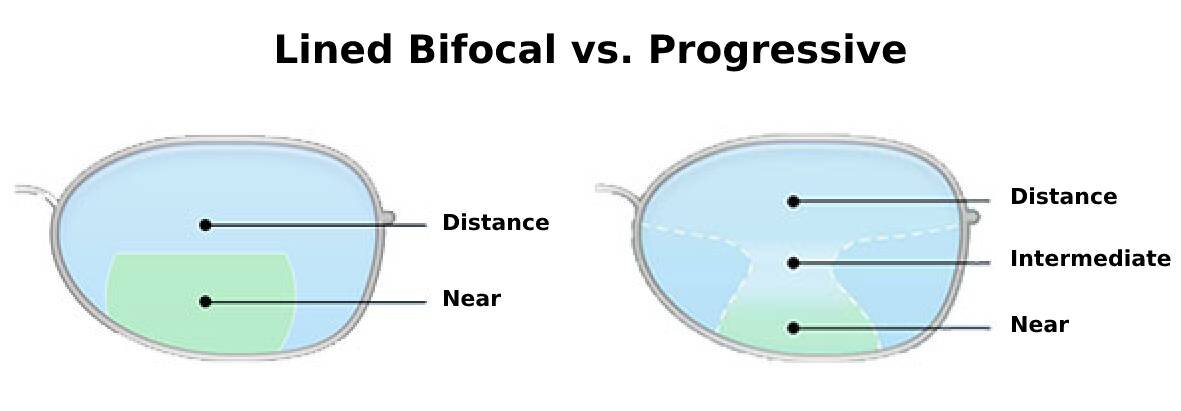Progressive Lenses vs Bifocals: What Makes Them Different
This post is intended to help you understand the differences between progressive and bifocal lenses as well as the pros and cons of each type of lens. Many people have heard the words progressives and bifocals and assume that they are synonymous terms. These lenses are actually quite different in terms of design and use. In this blog post, I will break down the differences between these two types of lenses and when to choose one over the other.
The first step is to understand when progressive and bifocals are needed in comparison to single vision lenses. If your new prescription has numbers under the “ADD” portion of the prescription, this likely means that a progressive or bifocal lens is necessary. Upon first glance, a prescription may look very complex as it has a multitude of numbers and confusing terms such as cylinder and axis. To further understand how to read an eyeglass prescription, visit our Simple Guide To Understanding Your Eye Prescription blog post.
Once we have decided that progressive or bifocal lenses are required, we need to further decide between which of these two lens designs. Let’s compare each so as to understand similarities and differences.
Pros and Cons of Progressive Lenses
Pros:
Provides clear vision at all distances
No need to remove glasses throughout the day
No horizontal line within the lens
Cons:
Longer adaptation period expected
Higher price range compared to bifocals
Pros and Cons of Bifocal Lenses
Pros:
Easy adaptation due to a clear cut transition between near and distance vision
Lower price point compared to progressive lenses
Cons:
No intermediate (computer) vision
Unappealing cosmetically due to horizontal line within the lens
_________________
I should add that a progressive lens allows for multiple prescriptions within one lens; these multifunction lenses accommodate your distance prescription, your intermediate prescription, and your near vision prescription.
Bifocals lenses as you’ve probably seen, have a visible horizontal line near the bottom of the lens. These were an older type of lens and we could say they are not as practical in this day and age. The reason for this is because a good portion of our day involves being on our computer screen, which we categorize as intermediate vision. Bifocals only correct for distance and close near vision; they do not correct for intermediate vision.
On the other hand, progressives include the added benefit of a line-free lens which gradually changes power as the user looks on down towards the bottom of the lens. This includes correcting for the intermediate vision of the patient. Intermediate vision is used for tasks such as computer work or looking at the dashboard in your car while driving.
There are many different types of lens designs; single vision, computer and office, progressives, bifocals, and anti-fatigue lenses. To further the complexity, within each class of lens there are numerous quality levels. Simply put, there is usually a “good”, “better”, and “best” lens design. In my other blog post, I answer the question: “Are There Different Types of Progressive Lenses and Does the Vision Quality Vary Between Them?”
The type of lens design for you is best chosen after a thorough discussion with your optometrist and optician to see what lenses will best suit your lifestyle. Similar to how a custom suit is styled and fit to meet your specific body shape and occasion, custom eyewear requires a good amount of specification in order to meet certain visual demands.
Stay one step ahead of screen vision loss. Book a personalized consultation with Della Optique’s skilled optometrists.
Are Progressive Lenses Good for Driving?
Yes! Progressive lenses are great for driving, since most prioritize distance vision. In addition to the distance benefits, patients will also notice an improvement when looking at the readings on their dashboards, as progressive lenses also correct for one’s intermediate vision.
An example of this is when drivers utilize a device for GPS mapping (phone or vehicle GPS device). The GPS device is usually about an arm’s length away (this is your intermediate vision). For some patients, this intermediate area may be quite blurry without progressive lenses.
These lenses are an all-inclusive design and should instill confidence that you’ll have clear and comfortable vision at all distances while sitting in the driver’s seat.
Are Progressive Lenses More Expensive Than Bifocals?
Yes, the price range for progressive lenses is usually higher when compared to the price range of bifocals. Remember that within each type of lens there is usually a “good”, “better”, and “best” lens design so usually everyone can find something that meets their budget and accomplishes their vision goals.
Although both lenses are custom made, the technology that is embedded within the lens is much more complex and advanced for progressive lenses compared to bifocals. In addition, the lab processing time for progressive lenses is considerably longer as their algorithms are more sophisticated.
_________________
Have any final questions before you book an eye exam with us? Visit our booking page or give us a call at (604) 742-3937.





